
Safe At Home in 2024?
Product recalls, warnings and penalties all increase in 2023. Dangerous products connected to 550 injuries and 15 deaths.

Downloads
EXECUTIVE SUMMARY
In May 2021, a 53-year-old woman was making a smoothie drink with vegetables. Within a minute of turning on her PowerXL juicer, she said it “exploded” and a piece of metal shot out and hit her in the stomach.
She suffered a one-inch cut, which would have been deeper and wider if she hadn’t been wearing a waist trainer, according to the report she filed a few days later with the Consumer Product Safety Commission (CPSC.)
She was one of 261 people to file complaints about Empower Brands’ PowerXL juicer – 47 of which involved injuries. Some of those were serious enough to require emergency medical treatment.
It took two years – until June 1, 2023 – for the company to recall 469,000 of the juicers in the United States (plus an additional 10,900 in Canada) and offer full refunds to customers. “The juicers can rupture during use, striking consumers and posing a laceration hazard, or can leave small particle shavings in the juice, posing an ingestion hazard to consumers,” the notice from Empower Brands said. The company acknowledged some of the injuries required medical care, including ingestion of small pieces or severe cuts that required stitches.
In the case of another problem product, which was also reported in May 2021, a person reported that their power sofa from Ashley Furniture caught on fire. The fire caused the person to be hospitalized and “extensive” property damage, according to the report filed with the CPSC.
That was one of at least six fires reported involving the Ashley Party Time power sofas, loveseats or recliners. The source of the fire: The products’ cup holders, which had LED lighting. Two years passed before Ashley in June 2023 recalled about 253,000 reclining products in the United States, plus an additional 9,450 in Canada, according to the notice from the CPSC.
These were two of 323 recall announcements from the CPSC in 2023. The recalls involve tens of millions of products – everything from appliances to tools to clothing to children’s toys. Some products were recalled only after dozens or hundreds of complaints. Some were recalled only after people were seriously injured or killed.
It’s unfortunate not only that so many dangerous products are sold, but it’s also disturbing it often takes months or years to get a dangerous product off the market, in part because the CPSC can’t force a recall, no matter how hazardous the product is, without a legal fight.
An analysis of all 323 of last year’s recall announcements by U.S. PIRG Education Fund shows:
- The number of recall announcements increased by more than 10% compared with 2022.
- The number of public warnings tripled from the year. The CPSC usually issues unilateral warnings when companies don’t cooperate with a recall.
- The types of products recalled most were children’s sleepwear, small vehicles such as ATVs and golf carts, toys, infant sleep products, furniture and small kitchen appliances.
- Among the 321 new announcements, 76 of the recalls involved injuries, some with multiple injuries. All told, more than 550 injuries were reported, ranging from minor cuts and burns, to paralysis and permanent brain injuries. Some of the injuries occurred in other countries.
- Eight of the new announcements involved deaths, with 15 people who died in connection with the products before they were recalled. Some of the deaths occurred outside of the United States. This doesn’t include the two re-announcements for infant rocker sleepers, linked to about 115 deaths. Tragically, at least 12 of the babies reportedly died after the rocker sleepers were recalled in April.
- More than 10% of all recalls involved fires, with as many as 500 fires linked to 38 dangerous products that were later recalled.
- The most common reasons for recalls include risk of fire (73,) burns (65,) falls (37,) lacerations (33,) choking (25,) toxics (14) and suffocation (12.)
- The number of companies that agreed to pay multimillion dollar penalties for not reporting products that pose a hazard increased again in 2023.
- Eight of the announcements were expansions, which means a recall was announced at some point in the past and the company determined that even more models of the product were dangerous and were recalled. There were two expansion announcements in 2022.
- Two of the notices were re-announcements, which occur when officials learn the products are still in people’s homes and are continuing to cause injuries, deaths or property damage. An alarmingly small percentage of all recalled products are returned, repaired or discarded. In 2022, there was one re-announcement.
- The total value of all 323 product recalls was between $12.9 billion and $24.6 billion, because, with any given recall, different models of the product were priced differently. This doesn’t reflect the amount companies actually paid out to customers.
Refunds were offered in about half of the recalls. Other companies mandated a repair or replacement and those wouldn’t have necessarily cost the company as much as a refund.
And of course, only 6% to 10% of recalled products are returned or submitted for a remedy.
The volume of hazardous products that are identified is only part of the problem. Regulators and lawmakers also should explore why it often takes so long to recall a product after serious safety issues are reported and people get hurt or even die.
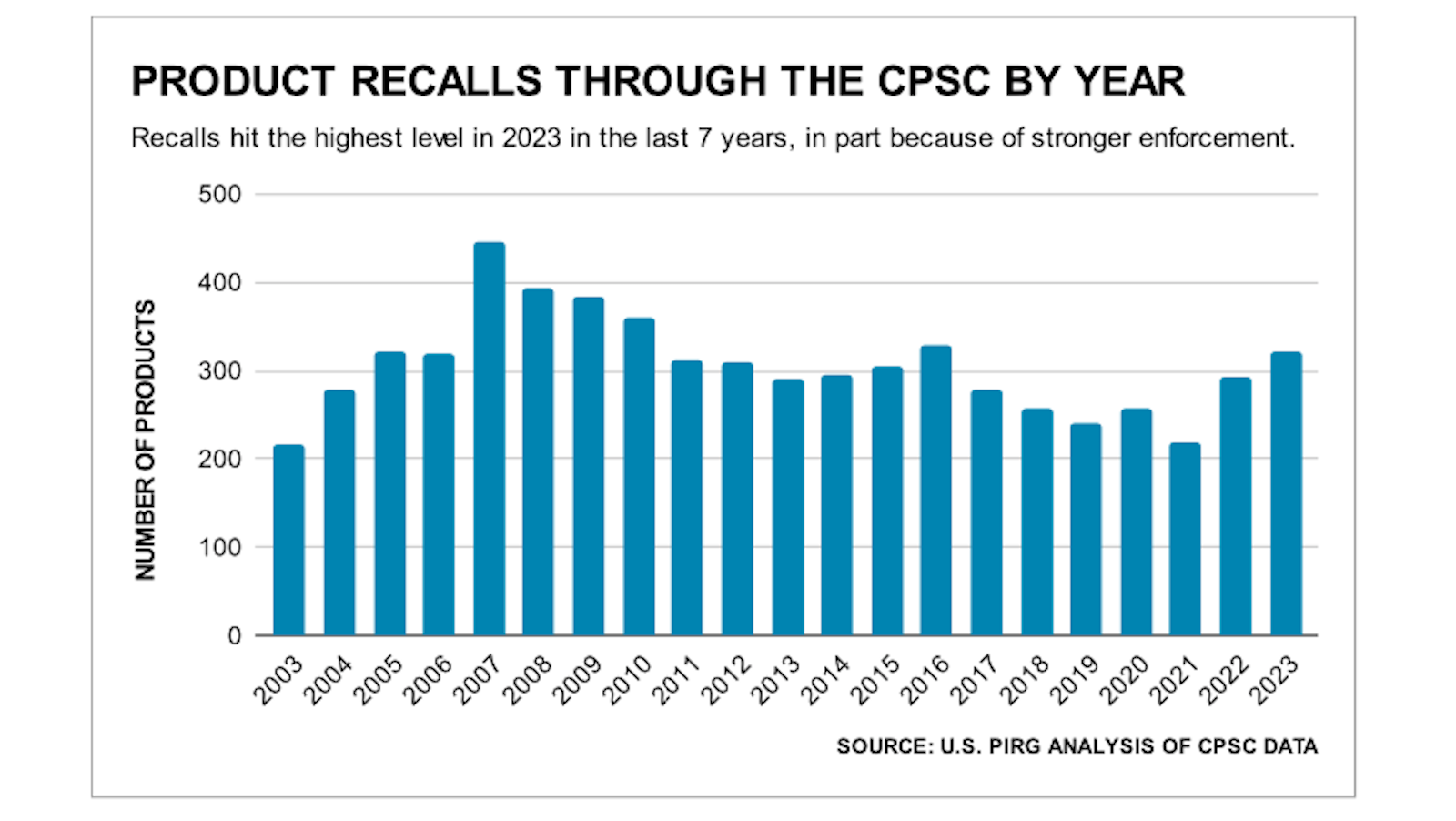
THE PATH TO A RECALL
Products are presumed safe until they’re not. In 2023, there were 323 recall announcements for items ranging from air fryers to chairs to toys to sporting equipment. That’s the most since 2016 and it’s the first time the number topped 300 since the same year. So how do products get recalled?
Virtually all recalls announced by the Consumer Product Safety Commission are voluntary by the company. Dangerous products are usually identified in one of three ways:
- The company identifies a defect through its own testing or monitoring after a product is offered for sale.
- Consumers complain to the company.
- CPSC staff investigate incidents reported by consumers, doctors, fire officials or others on SaferProducts.gov. CPSC staff also review death certificates and other records to spot possible problems, do secret shopping and conduct testing.
Among the roughly 15,000 products regulated by the CPSC, only a small number must comply with specific standards before being offered for sale. About 250 types of products, such as bicycles, garage door openers and medication bottles, must meet specific safety standards, which differ from product to product. That total includes various categories for all children’s products – meaning those “designed or intended primarily” for children 12 or younger. This covers toys, clothing and other items. They must meet standards for issues such as lead and phthalates, small parts and warning labels. The standards include third-party testing and certification.
So recalls can occur when testing shows a consumer product violates safety standards for that product, before an incident or injury has occurred. Often, however, they happen after a consumer has complained, after someone has been hurt, or after a doctor, hospital or coroner has filed a public report. The product is recalled after the incident is linked to a safety issue.
One in four of last year’s recalls –– 84 products — followed visible injuries or deaths. An additional 25 recalls occurred after fires without injuries. Of the rest, 126 (39%) were recalled without any incidents reported to the CPSC, which suggests testing or issues detected by the CPSC or the company prompted the recall.
READ MORE ABOUT THE PATH TO A RECALL
In the last two decades, 2007 saw the highest numbers for product recalls. An alarming number of children’s products were recalled that year because of lead. Among the 447 recalls that year, more than 100 stemmed from excessive levels of lead in paint used on the products. In 2007, there was no limit on the amount of lead allowed in children’s products, except for lead in paint and surface coatings.
That left children unprotected from other potential lead exposures, even though lead is a known neurotoxin that can cause brain damage, learning disabilities and behavioral problems. The maximum level for paint and surface coatings of toys and other children’s products was 600 ppm, a standard set way back in the 1970s.
Among the products recalled for lead in 2007:
- About 7 million Thomas & Friends wooden train and railway toys because the surface paint contained excessive lead levels. The original June recall was expanded in September to include more toys.
- Nearly 1 million toys with characters from Sesame Street, Dora the Explorer and other popular children’s TV shows. The toys’ surface paint contained lead levels above the allowed limit.
- Millions of other products ranging from school supplies to jewelry to stuffed animals.
Because of that disturbing trend, Congress the following year passed the Consumer Product Safety Improvement Act that, among other things, implemented safety standards for lead and other toxics in products that children play with, wear or interact with.
Despite those clearly testable standards, 13 of last year’s recalls stemmed from excessive levels of lead and, in some cases, other toxins too. The products included children’s sippy cups, jewelry and clothing. Lead is particularly concerning because you can’t see it or smell it, but it could be harming children without detection until years later.
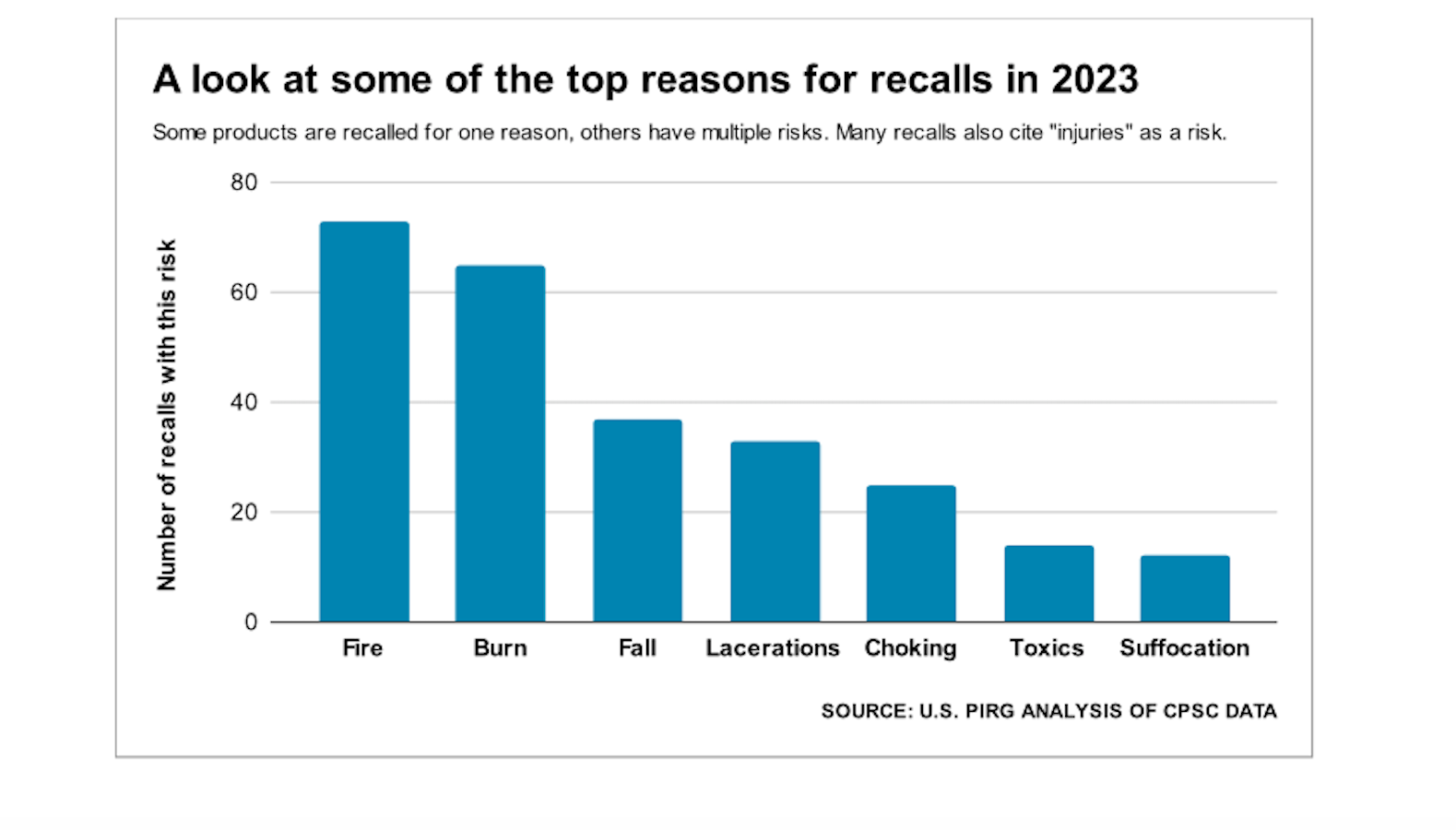
CPSC WARNINGS INCREASED IN 2023 AFTER COMPANIES WOULDN’T RECALL PRODUCTS
The CPSC in 2023 issued three times more public warnings about products when a company refused to cooperate with a voluntary recall, in part because the CPSC is cracking down and in part because of new safety standards companies must follow.
Even when the CPSC believes a product poses a threat, the regulator can’t just recall it without the company’s cooperation. The Consumer Product Safety Act’s Section 6(b) prohibits the CPSC from publicly disclosing derogatory information about a product unless it has notified the company and waited 15 days. That gives the company enough time to file a lawsuit to block the disclosure. To avoid court battles, the CPSC often negotiates recalls with companies, which can take weeks or months, as we’ve seen.
However, the 15-day wait doesn’t apply if the Commission “publishes a finding that the public health and safety require a lesser period of notice,” per 15 U.S.C. 2055 (6)(b)(5)(D).
The CPSC sometimes chooses to announce a warning about a specific product, by name, even if the company isn’t cooperating with a recall.
Last year, the CPSC issued at least 38 such warnings, compared with just 11 in 2022.
CPSC Commissioner Peter Feldman, who began serving in 2018, has pushed for more warnings for years because they allow the CPSC to notify consumers more quickly and negotiate stronger recalls.
“What used to be an empty threat, people are now taking them more seriously,” Feldman said in an interview with U.S. PIRG Education Fund. “Companies in the past might have been recalcitrant. Now we’re seeing a greater willingness to negotiate recalls.”
READ MORE ABOUT PRODUCT WARNINGS
CPSC Chair Alex Hoehn-Saric, who became chair in 2021, said such warnings were “once a rare occurrence.” Now, however, they’re “an important part of our toolbox, especially for products sold by foreign manufacturers on e-commerce websites,” he said in a February speech at the annual International Consumer Product Health and Safety Organization conference.
“Too often these sellers ignore outreach from the CPSC or disappear altogether when a defect is identified,” Hoehn-Saric said. “Consumers have a right to know about hazardous products in their homes and before they buy. And it is not fair for responsible companies to compete against businesses that cut corners on safety.”
For example, at the end of 2023, the CPSC warned the public to stop using baby loungers sold by Poetint002 of China because they violate federal standards for infant sleep products that took effect in 2022. The CPSC notified Poetint002 that it’s violating the law, “but the firm has not agreed to recall these loungers or offer a remedy to consumers,” the CPSC said. The products were sold on Amazon and other online marketplace sites.
Other warnings issued in 2023 because companies weren’t cooperating:
● BQQZHZ combination smoke and carbon monoxide (CO) detectors.
The CPSC said the detectors can “fail to alert consumers to the presence of hazardous smoke and fire.” Consumers with these faulty detectors could be at risk of smoke inhalation and death, the CPSC said. “This is a situation involving foreign firms who have not responded torequests for a recall,” the CPSC said. It noted that the chance of dying from a fire is double in a home without a working smoke detector.
The BQQZHZ detectors failed to detect certain concentrations of smoke, which is a violation of UL 217. They were sold on Amazon.com for about $46.
● Mollys Products’ sodium hydroxide.
The CPSC said the products don’t comply with child-resistant packaging rules under the Poison Prevention Packaging Act. Children “can easily access the substance,” the CPSC said, and be at risk of chemical burns and skin or eye irritation.
The item was sold on Walmart.com from 2018 through March 2023 for about $15 for a 32-ounce bottle. The seller, listed as Burgess Jackson, Inc. of Philadelphia, Pa., hadn’t agreed to a recall, the CPSC said.
● Vera Natura adult bike helmets.
The CPSC said the helmets may fail to protect riders in a crash, which could lead to a head injury. The helmets don’t comply with federal safety standards. The helmets were sold on Walmart.com from August 2022 through February 2023 for about $11. “The seller, Tengingyue, of China, has not agreed to recall these helmets or offer a remedy to consumers,” the CPSC said.
Among all of the warnings in 2023, 12 involved high-powered magnets that didn’t meet federal requirements for magnets marketed as toys, eight involved infant sleep products that violated federal rules, six involved bike helmets that didn’t meet safety standards and three involved smoke detectors that didn’t detect smoke.
The volume of warnings in 2023 shows that the law known as 6(b) does not prevent the CPSC from protecting the public, Feldman said. The 38 warnings last year “should put to bed this myth.”
Instead of issuing a warning about a specific product, the CPSC may release a generic warning about a type of product, without identifying the specific product or the company if the company isn’t cooperating. For example, in 2020, the CPSC issued a warning about nursing pillows, saying it had “identified deaths possibly associated with pillow-like products and continues to analyze incident data with the goal of determining the risks with these products.”
A year later, The Boppy Co. of Colorado recalled 3.3 million of its newborn loungers/pillows. “There have been eight reports of infant deaths associated with the Boppy Company Newborn Lounger and this hazard.
The infants reportedly suffocated after being placed on their back, side or stomach on the lounger and were found on their side or on their stomach. The infant deaths occurred between December 2015 and June 2020,” the notice posted by the CPSC said.
Still, warnings are not as good as recalls, Feldman said, in part because cooperation gives the CPSC the ability to require direct consumer notification and multiple notices of direct contact when possible. The CPSC can’t do that with warnings alone.

Safe At Home in 2024?
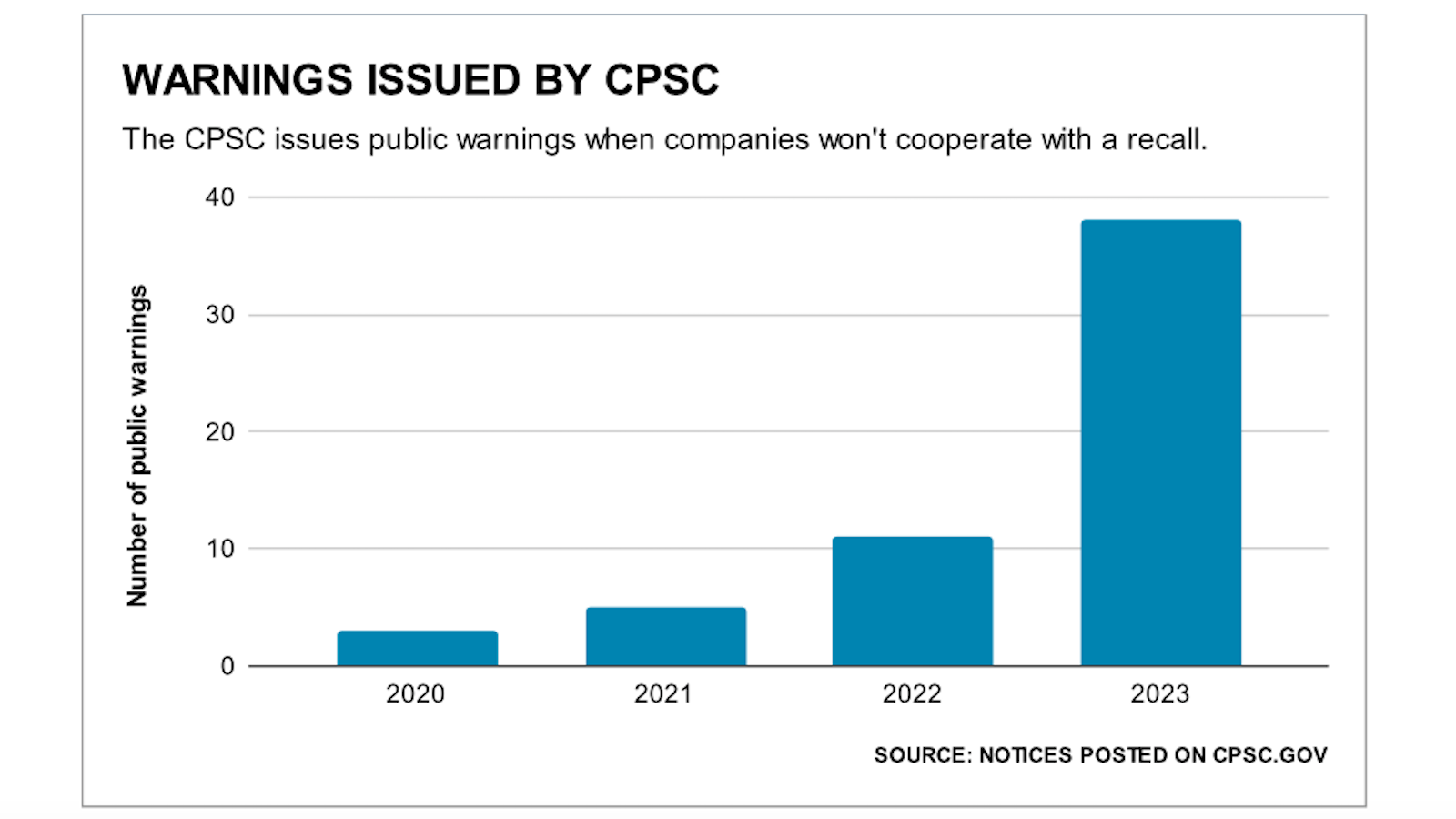
MORE THAN HALF OF RECALLS WERE “FAST- TRACKED”
With about half of the recalls in 2023, companies applied to “fast track” the process.
Companies that want to get potentially dangerous products off the shelves and, hopefully, out of people’s homes quickly can report a defective product (as they’re required to do by law.) They can then try to work with the CPSC to recall the product within 20 working days and issue a refund, repair or replacement without a fuss.
If the CPSC agrees with the company’s proposed plan, it won’t designate that the product represents a “substantial hazard” and won’t spend staff time investigating the possible defect. The fast track program was tested in 1995 and adopted in 1997. The CPSC made the fast track program easier for businesses in January 2022. The fast track program reduces red tape and possible liability for businesses.
It’s not surprising to CPSC Commissioner Rich Trumka that more than half of companies last year opted to “fast track” the process.
“My sense is that companies see that this Commission is more willing than ever before to go after companies that don’t report hazards to us and don’t act to quickly recall dangerous products,” Trumka said.
Why doesn’t every business agree to fast track a recall for an unsafe product after deaths or multiple reports of serious injuries or property damage? “Some companies choose not to participate in the Fast Track Recall Program,” the CPSC explains on its FAQ, “because they may not have made the decision to cooperate voluntarily with the CPSC on a potential corrective action; or they may not be able to move quickly enough to meet CPSC deadlines for participants.”
In those cases, the companies can choose to delay the recall process, either with drawn-out negotiations or flat-out refusal to cooperate, even if fires, injuries or deaths have been associated with the product.
SOME COMPANIES DRAG THEIR FEET FOR MONTHS OR YEARS
One of the most frustrating aspects of product safety is that dangerous products often take months or years to get recalled after credible complaints have been filed with the CPSC or the company. Some of these complaints come from doctors, coroners or other officials.
With any complaint filed with the CPSC through SaferProducts.gov, the CPSC investigates to determine whether the product represents a hazard or demands “corrective action.” There isn’t a time limit on how long that investigation could take.
And when you throw in the fact that companies sometimes don’t cooperate with the CPSC or challenge the recommended “corrective action,” it’s appalling but not surprising that a recall frequently occurs months or years after the first complaints.
The PowerXL juicer and Ashley Party Time furniture cases mentioned above took at least two years from the first public complaints until the recall was announced.
Here are a few other cases from 2023 when the recall took months or even years:
Jetson scooters/hoverboards
In April 2022, two sisters, ages 10 and 15, died in a fire in Hellertown, Pa. “The Hellertown Borough Fire Marshal determined that a 42-volt Jetson Rogue (hoverboard) was the point of origin of the fire,” according to the announcement by the CPSC. “The fire then spread from the room of origin to other portions of the house, resulting in the deaths of the two girls and smoke inhalation injuries to the girls’ parents.”
In addition, the announcement said, “There have been multiple other reports of the recalled scooters/hoverboards burning, sparking or melting, several of which involved reports of flames.”
In March 2023, nearly one year after the girls died, Jetson Electric Bikes LLC recalled about 53,000 of the scooters/ hoverboards because the lithium-ion battery packs can overheat and cause a fire.
Customers were offered refunds. The items were sold through Target and Jetson for $100 to $150.
Target Threshold candles
In July 2022, a 24-year-old woman said her 20-ounce Target Threshold candle with the apple blossom and breeze scent “exploded.” Glass and burning liquid wax shot out, landing on a wall tapestry in the room.
“It burned out quickly,” but the burning liquid wax could have “set the room ablaze,” the woman’s mother wrote in the report to the CPSC on SaferProducts.gov. That was one of 137 reports of the Target Threshold candles breaking or cracking while in use. Six people reported severe burns or cuts.
Ten months later in May 2023, Target recalled nearly 5 million of the candles, with refunds of $3 to $20 offered to customers who returned the candles in person or by requesting a prepaid shipping label.
Luxor audio/video cart
Over a 10-year period, from 2006 to 2016, three children died and one child was seriously injured after a television on an A/V cart fell off and landed on them, according to the CPSC. The carts were frequently used in schools, daycare centers and churches.
A person claiming to be a former Luxor employee told the CPSC in a written complaint in May 2021 that they knew of multiple incidents that killed children when a TV or other heavy object either tipped over after a cart collapsed or a child tried to climb on the cart or pull the object down.
The complainant said the company settled lawsuits but declined to recall the products.
“Today they still have weight ratings on their products I know are unsafe and false. I feel this should be looked into as there are 10,000 to 100,000 units if not more in our public schools,” the person wrote. “There are legal cases for every instance.”
Nearly two years later, on April 13, 2023, Luxor recalled 84,700 of the carts in the United States, covering 325 models of the plastic or metal carts that were sold since the 1980s. After contacting Luxor, customers could get free metal kits to be installed on the lower shelf to make the bottom heavier and the cart more stable. Luxor would also send new warning stickers for each shelf that no more than 25 pounds should be put on any shelf. The carts sold for $125 to $250.
Onewheel electric skateboards
In July 2019, the CPSC received a report of an 18-year-old man who was traveling 20 to 30 mph on a Onewheel+ skateboard when it stopped suddenly and he was thrown off face first. He was taken by ambulance to the hospital and diagnosed with injuries including severe traumatic brain injury as a result of brain bleeding, seizure-like activity, memory impairment, deteriorating vision, severe balance problems and blunt chest trauma.
In January 2021, a 55-year-old reported to the CPSC that a just-purchased Onewheel posed a huge danger: When either the Onewheel sustains a computer failure or is pushed beyond the recommended speed, it doesn’t just stop immediately – it stops and “tips forward at the extreme angle and results in catapulting the rider headfirst into the (ground),” the consumer wrote. The report noted there were a “huge number” of videos online that show this danger.
Still, the product remained on the market in 2021, despite four deaths reported in connection with the Onewheel from 2019 to 2021, the CPSC said.
In another report, from November 2022, a 47-year-old said his arm was broken into four pieces and he required surgery after his Onewheel threw him forward two months earlier. In another report from November 2022, a 31-year-old, who said he was wearing a helmet when thrown off the Onewheel. He was taken by ambulance and suffered head trauma, broken facial bones and is now blind in his left eye, following an incident the month before, the report said.
The same month in 2022, the CPSC issued a warning naming Onewheel. At least 51 complaints about Onewheel skateboards were filed with the CPSC in 2022. Forty- seven of them said riders were ejected or fell after the skateboard stopped abruptly or the self-balancing feature stopped. In 42 of the cases, the riders ranged in age from 30 to 58, a 2023 analysis by U.S. PIRG Education Fund showed.
More than four years after the first brain injury was reported to the CPSC and at least a year after the CPSC knew about the four deaths, Future Motion on Sept. 29. 2023 recalled all models of its Onewheel skateboard, totaling about 300,000 products.
In the 10 months after the CPSC was alarmed enough to issue a warning but before the more widely publicized recall, numerous incidents were reported to the CPSC.
Among them: A 41-year-old woman who was ejected from a Onewheel Pint X into the road and hit her head on Aug. 17, 2023, according to a report filed by her sister with the CPSC on Sept. 22, 2023. “She was declared brain dead at the hospital that day,” the report said. “She was very good at riding the scooter. (Rode) it daily.”
In another incident, a 61-year-old man was thrown off the Onewheel Pint on June 20, 2023 and hit his head. “He was unconscious for 4 minutes and when he woke up he didn’t know where he was, who he was and could barely speak. He suffered a subdural hemorrhage and a subarachnoid hemorrhage,” his wife wrote in the report filed with the CPSC. “He is out of work and was in ICU and now is going to inpatient rehab. He has excruciating headaches.”
The skateboards sold for $1,050 to $2,200, depending on the model. The recall said the safety of most of the newer models could be improved with a warning system that could be downloaded. Older models didn’t have this capability; customers with those models were entitled to “a prorated refund in the form of a store credit upon confirmation of disposal of the product.”
You have to wonder how many of these serious incidents may not have occurred if the company had recalled Onewheel sooner.
COMPANIES ARE REQUIRED TO REPORT A POSSIBLE RISK
Whether a company wants to recall a product quickly or not, it is required by law to notify the CPSC within 24 hours if they receive information that “reasonably suggests” one of their products could pose a health or safety risk. That doesn’t mean they’re accepting liability.
The law covers manufacturers, importers, distributors and retailers. The issues they’re required to notify the CPSC about include:
- A defective product that could injure.
- A product that “creates an unreasonable risk” that could seriously injure or kill someone.
- A product that doesn’t comply with consumer product safety rules.
- A case of a child choking on a marble, small ball, latex balloon or other small part in a toy or game and that causes the child to get medical treatment, stop breathing, suffer a serious injury or die.
- For manufacturers and importers, certain kinds of lawsuits.
Despite that, several large companies got in trouble for not reporting problems to the CPSC and agreed to settlements in 2023 to resolve CPSC lawsuits.
In fact, in another example of the CPSC stepping up enforcement, there were five such cases in 2023, following three in 2022.
There were only four such settlements in the previous six years combined.
The 2023 settlements were:
Peloton Interactive, Jan. 5, 2023
Peloton Interactive Inc., of New York, agreed to pay a $19.1 million civil penalty. The settlement follows two charges by the CPSC that Peloton knowingly failed to report injuries and other incidents questioning the safety of its Tread+ treadmill over a period of months, and knowingly distributed recalled treadmills after the recall.
When Peloton finally told the CPSC, it had received more than 150 complaints that people, pets or objects had been pulled under the back of the treadmill. One child died and 13 people were injured, including broken bones. Peloton and the CPSC announced the recall of the Tread+ treadmill on May 5, 2021.
Generac Power Systems, May 5, 2023
Generac Power Systems, Inc., of Waukesha, Wisconsin, agreed to pay a $15.8 million civil penalty. The settlement follows charges by the CPSC that Generac failed to report incidents from consumers whose fingers were partially amputated or crushed by the unlocked handle of its portable generator for more than a year, from October 2018 and into 2020.
When Generac finally told the CPSC, five people suffered finger amputations while trying to move the generator. Generac and the CPSC announced a recall on July 29, 2021.
Whirlpool Corp., Aug. 24, 2023
Whirlpool Corp., of Benton Harbor, Mich., agreed to pay an $11.5 million civil penalty. The settlement follows charges by the CPSC that Whirlpool knowingly failed to report that 17 models of its cooktops “contained a defect that could create a substantial product hazard and created an unreasonable risk of serious injury to consumers” following 157 complaints of electric cooktops turning on by themselves.
When Whirlpool finally told the CPSC after more than a year, from November 2017 through early 2019, complaints about the 17 JennAir, KitchenAid and Whirlpool cooktop models included 14 reports of property damage, four reports of things catching on fire and two minor burn injuries. Whirlpool and the CPSC announced a recall August 28, 2019.
BJ's Wholesale Club, Sept. 29, 2023
BJ’s Wholesale Club Inc. of Marlborough, Mass., agreed to pay a $9 million civil penalty. The settlement follows charges by the CPSC that BJ’s knowingly failed to report that Royal Sovereign brand portable air conditioners it sold contained a defect that put customers at risk of injury or death. BJ’s sold 1,778 of these air conditioners in 2011 and 2012, and 509 of them were returned to the store. In August 2016, one of the air conditioners sold by BJ’s was involved with a fire at a house in New York, with a woman and her two children inside. They were rescued, but the woman later died.
BJ’s was informed about the fire no later than March 2017 and issued a warning to customers in March 2021 but still didn’t inform the Commission, CPSC Chair Alex Hoehn-Saric said in a statement. Royal Sovereign and the CPSC announced a recall on December 22, 2021.
HSN Inc. (formerly Home Shopping Network,) November 08, 2023
HSN Inc., of St. Petersburg, Fla., agreed to pay a $16 million civil penalty. The settlement follows charges by the CPSC that HSN knowingly failed to report that its Joy Mangano-brand My Little Steamer and My Little Steamer Go Mini contained a defect that could cause injuries. From late 2012 until early 2019, HSN received “numerous” complaints that the steamers “would spray, expel, and/or leak hot water while in use, leading to serious and permanent injuries, a limited number of which constituted grievous bodily injury.”
When HSN finally told the CPSC, it had received about 400 complaints of the steamers spraying or expelling hot water and about 700 more reports of leaks. Among the complaints: at least 91 injuries and 29 insurance claims regarding injuries including second and third-degree burns and one case of hearing loss. There were about 650 additional complaints on HSN Online Reviews. HSN and the CPSC announced a recall May 26, 2021.
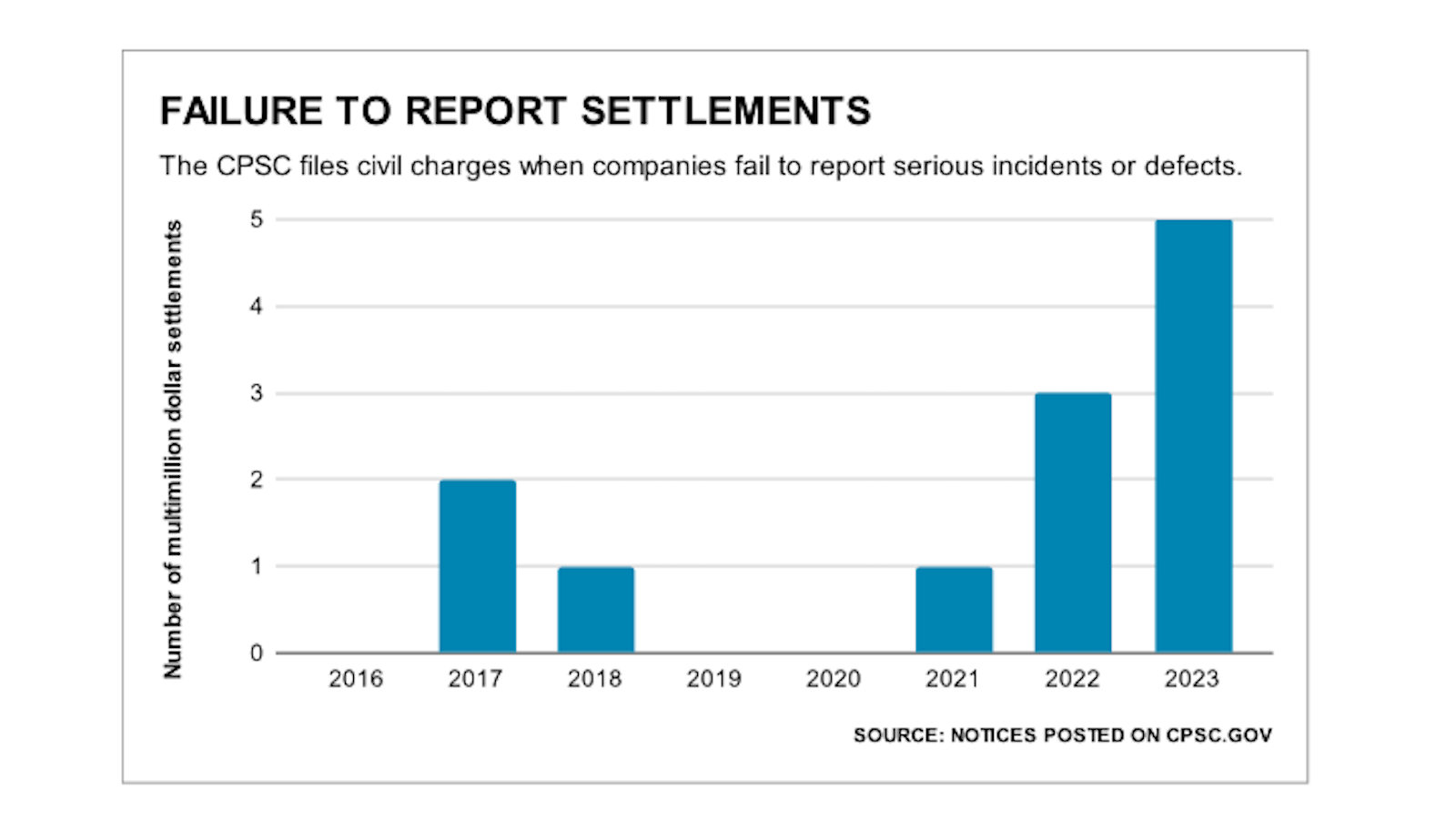
THE FIRST CRIMINAL CONVICTIONS FOR FAILING TO REPORT DEFECTS
With all products, the CPSC has stressed that officials won’t tolerate companies neglecting to notify them about injuries, deaths, fires or other serious incidents involving their products. The law says failure to furnish information required by Section 15(b) could lead to “substantial civil and criminal penalties.”
That happened for the first time in 2023. In November, a jury found two former executives of Gree USA Inc. guilty of conspiracy to defraud the CPSC and knowingly and willfully failing to report known problems with millions of defective dehumidifiers sold for years starting in 2005. The Department of Justice filed criminal charges and the two were indicted in 2019. The dehumidifiers were sold under brands including Frigidaire, GE, Gree, Kenmore and SoleusAir.
The dehumidifiers were potentially linked to four deaths, 450 fires and $19 million in property damage, the CPSC said. In addition, there were more than 2,000 complaints of the recalled dehumidifiers overheating.
Gree USA Chief Administrative Officer Simon Chu and CEO Charley Loh were charged with knowing their products were defective and could catch fire, and knowing they were required to report the information to the CPSC, but intentionally did not notify the CPSC.
These are the first-ever criminal convictions against executives for failing to report issues with a dangerous product to the CPSC.
READ MORE ABOUT CONVICTED GREE EXECUTIVES
“The use of this powerful deterrent should send the message that when bad actors endanger people by hiding critical safety information, they will be met with unwavering pursuit and severe consequences. This knowledge should deter other executives from withholding the information CPSC needs to protect the American public,” CPSC Commissioner Richard Trumka said in a statement. “If CPSC had known about the hazard sooner, it’s possible that at least four deaths from house fires would have been prevented.”
About 2.5 million Gree dehumidifiers were first recalled in September 2013. The number of dangerous dehumidifiers was expanded multiple times, then re-announced in 2016. The four deaths potentially caused by Gree dehumidifiers, the CPSC said, followed house fires in Ohio in 2016, and in Iowa and Missouri in 2022.
In a massive new recall in August 2023, the company recalled 1.56 million more dehumidifiers, covering 42 models under brand names including Kenmore, GE, SoleusAir, Norpole and Seabreeze.
Gree in 2016 agreed to pay a $15.45 million civil penalty – a record at that time – for failing to report incidents. That was after the company knew in 2012 about fires connected to the dehumidifiers, but before the four deaths. Gree Zhuhai and Gree Hong Kong agreed to a penalty of $91 million and agreed to pay restitution to victims of fires caused by the dangerous dehumidifiers.
Failure-to-report cases like Gree’s and others involving Peloton, Whirlpool and Generac fueled a new proposed bill in Congress. Sen. Peter Welch (D-Vt.) in January introduced The Consumer Advocacy and Protection (CAP) Act, which is aimed at holding companies more accountable for dangerous products.
Specifically, the CAP Act would:
- Eliminate the maximum civil penalty a company can face after a series of violations. The cap is currently $17.5 million per series.
- Increase the cap for a single violation from $100,000 to $250,000 and
- Clarify the types of offenses that fall under CPSC enforcement authority.
The bill is supported by Sens. Richard Blumenthal (D-Conn,) Edward Markey (D- Mass.), Brian Schatz (D-Hawaii), and Ben Ray Luján (D-N.M.)
Reps. Jan Schakowsky (D-Ill.) and Bonnie Watson Coleman (D-N.J.) introduced a companion bill in the House.
Lawmakers say it’s unacceptable that huge corporations can commit offenses that endanger consumers and then face little more than a slap on the wrist.
E-COMMERCE COMPANIES EVADE REGULATION – FOR NOW
So much shopping today occurs online. It’s estimated that more than 40% of clothing is purchased online today, along with 17% of consumer electronics and 14% of toys and children’s products. Yet consumers have far less protection when shopping online.
There’s just not as much accountability and scrutiny. This is particularly true for online marketplaces that host third-party sellers.
Companies must follow various safety requirements depending on whether they’re a manufacturer, distributor, importer, private labeler or retailer. But there’s disagreement about which category covers online marketplaces that sell products for third parties.
This is an issue when a company such as Amazon sells products that violate safety standards or companies such as Facebook Marketplace or eBay sell dangerous products that have been recalled. Brick-and- mortar stores face consequences if they do the same thing.
“More needs to be done with respect to e- commerce,” Feldman told U.S. PIRG, “including clarifying our jurisdiction over e-commerce platforms and policing the illegal resale of recalled and dangerous goods.”
Amazon could soon be classified as a distributor, which would be a game-changer. Nearly 40% of e-commerce in the United States runs through Amazon.
READ MORE ABOUT E-COMMERCE COMPANIES
Back in 2021, the CPSC sued Amazon for selling dangerous products from third-party sellers. It documented three hazardous products: carbon monoxide detectors that didn’t detect carbon monoxide, children’s pajamas that didn’t meet flammability standards and hair dryers that didn’t have shock protection in case the item comes in contact with water.
Amazon said then and maintained in a hearing in December 2023 that it’s a “third- party logistics provider,” not a distributor. An administrative law judge decided otherwise, paving the way for the CPSC to classify Amazon as a distributor. A decision could come anytime. This could make Amazon subject to more enforcement and accountability, both from regulators and customers who might file lawsuits.
Meanwhile, the lawmakers and regulators are also frustrated with online marketplaces such as Facebook Marketplace, eBay, Mercari and others, which often sell recalled products, even though it’s illegal to sell such products. All that regulators and lawmakers can do is issue “takedown” requests asking the companies to remove the products from their websites and stop selling others in the future.
Last summer, House Energy and Commerce Committee Chair Cathy McMorris Rodgers (R-WA), Ranking Member Frank Pallone, Jr. (D-NJ) and others on the committee sent letters to 17 online companies, pressing on how much they actually do to avoid selling recalled products and items that violate safety standards.
It may come down to Section 230 of the 1996 Communications Decency Act, which some say insulates online platforms from being responsible for products sold illegally on their websites. It says: “No provider or user of an interactive computer service shall be treated as the publisher or speaker of any information provided by another information content provider.”
The internet is a different phenomenon than it was in the 1990s, and many would say that publishing opinions is one thing and allowing the illegal sale of goods is something else.
HOUSE ENERGY AND COMMERCE COMMITTEE'S LETTER TO ONLINE MARKETPLACES
The chairs and ranking members asked companies to provide answers to the following questions last summer:
- What systems do you have in place to ensure recalled products that the CPSC has determined pose a serious risk of injury and potential death are not able to be posted to your marketplace?
- Do you have a compliance staff dedicated to consumer product safety issues?
- If so, how many full and or part time staff are on that team?
- What actions do you take to monitor CPSC recalls?
- What actions will you take to ensure that the Fisher Price Rock ‘n Play, Boppy Newborn Lounger, and similarly designed and/or other recalled products are not available on your platform moving forward?
- Are there statutory issues that are creating a gray area where it is unclear what the platform’s responsibilities are?
- Will you commit to working with the Committee to find a solution to this, to ensure that CPSC’s resources are not wasted on sending thousands of takedown requests for products that pose a known hazard and are for sale on your marketplace?
CONCLUSION AND RECOMMENDATIONS
We know that parents, caregivers, families, shoppers of all types generally assume that because something is for sale, it must be safe. Of course, that’s often tragically wrong.
Consumers’ safety could improve if:
- Congress or courts would act to clarify that the 1996 Communications Decency Act doesn’t insulate online platforms from responsibility for products sold illegally on their websites. This would give the CPSC more authority to pursue enforcement against platforms such as Facebook Marketplace and eBay, just like the regulator does with big box retailers.
Consumers’ safety could also improve if Congress would:
- Support the Sunshine in Product Safety Act, or similar legislation, which would allow the CPSC to warn consumers more quickly about all kinds of dangerous products, including toys, in advance of a It was first introduced in 2021. It was reintroduced in March 2023 in the House and Senate. Unilateral warnings from the CPSC are good, but not as good as a recall.
- Bolster the resources of Customs and Border Protection and the CPSC to provide more staffing at the border to stop dangerous imports, especially toys and other products, from entering the country. The bipartisan Securing America’s Ports of Entry Act would provide more CBP staffing, although not necessarily focused on counterfeits and other dangerous products.
- Empower the CPSC with mandatory recall authority without suing in cases where it believes a product represents a grave threat, based on reports from hospitals, fire departments or coroners and complaints from consumers. The CPSC should also be authorized to recall a dangerous product when a company isn’t being responsive, especially an international company.
- Pass the CAP Act, which would increase the civil penalties companies could face if they violate product safety laws and endanger people, especially children.
- Pass the Ban Water Beads Act, which would categorize water beads as a hazardous product under section 8 of the Consumer Product Safety Act. The bill was introduced after the July 2023 death of a 10-month-old baby in Wisconsin who had swallowed water beads, and the injury of a 9-month- old baby in Maine who’d swallowed water beads, causing an intestinal obstruction requiring surgery.
- About 7,800 children were treated in emergency rooms from 2016 through 2022 for injuries or illnesses caused by water beads, according to data from the CPSC.Buffalo Games recalled about 52,000 Chuckle & Roar Ultimate Water Beads Activity Kits on Sept. 24, 2023. The product was connected to the death of the Wisconsin baby and injury of the Maine baby. The water beads were manufactured in China and imported by Target Corp. of Minneapolis, Minn.
- Empower the CPSC to continue to research the risks of phthalates and other toxics. Laws were passed on lead and some phthalates in children’s products. There are more toxic chemicals we should learn more about.
- Work to fix the broken product recall system, by requiring companies to do more to notify customers about recalls and by requiring companies with recalled products to have a consumer-friendly process to get a refund, repair or replacement.We know this is possible because so many companies large and small do this already. Half of the companies that offered refunds in 2023 had a reasonably easy remedy request process, according to research and an analysis we published last month in our Too Much To Recall report.When recalls are difficult to get, dangerous products remain in people’s homes, with the potential for even more calamities.
- Give the CPSC more resources. The CPSC is supposed to protect the public from dangers that may exist with 15,000 different kinds of consumer products. The CPSC has the authority to set mandatory safety standards; influence voluntary safety standards; require labeling; force hazardous products to be removed from store shelves; pursue product recalls; educate the public about product safety; and collect and analyze data about injuries, death and incidents. The CPSC reviews about 8,000 unintentional product- related death certificates each year, and tracks at least 15.5 million injuries each year that are treated in emergency rooms and associated with consumer products.
In addition, the CPSC should:
- Push companies harder to do more to alert customers to recalls. Besides notifying customers who’ve provided contact information, companies could amplify the recall through social media, and targeted advertising and newspaper legal notices. The CPSC should also push companies to offer an easier process to request a refund, repair or replacement; the onerous process that exists now deters consumers from getting dangerous products out of their homes.
- Improve the CPSC’s saferproducts.gov For consumers searching for past complaints or incidents about a particular product, it’s often not easy to find reports. For example, if you search for reports about an XYZ brand refrigerator and you type in “XYZ refrigerator,” it will show you every report mentioning either: any product made by XYZ, or any brand of refrigerator. It can be cumbersome to wade through the complaint summaries of reports that aren’t what you’re looking for.Using the site’s “advanced search” function does help a bit. But the search results are erratic And if you want to amend a search where you entered numerous search parameters, the process just isn’t very user- friendly.
LINKS TO OUR DATABASE AND DETAILED ANALYSIS
ALL 323 RECALL ANNOUNCEMENTS IN 2023
with product type, hazards, reported incidents, cost and how easily consumers can request a refund or other remedy
CPSC UNILATERAL WARNINGS
about specific products, 2020-2023
CIVIL PENALTY SETTLEMENTS
for failing to report incidents, 2016-2023
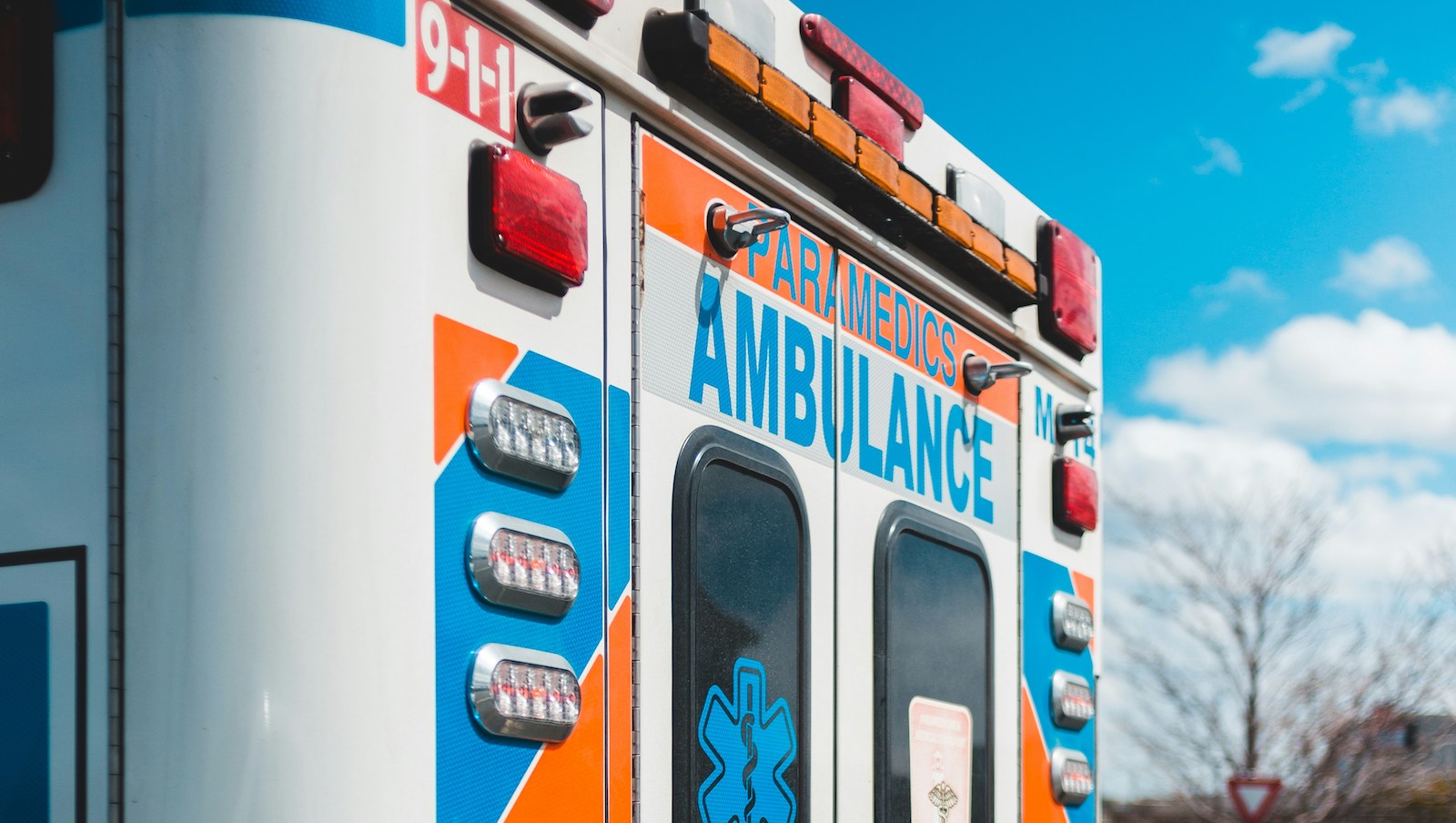
Tips to find out about product recalls
Topics
Authors
Teresa Murray
Consumer Watchdog, U.S. PIRG Education Fund
Teresa directs the Consumer Watchdog office, which looks out for consumers’ health, safety and financial security. Previously, she worked as a journalist covering consumer issues and personal finance for two decades for Ohio’s largest daily newspaper. She received dozens of state and national journalism awards, including Best Columnist in Ohio, a National Headliner Award for coverage of the 2008-09 financial crisis, and a journalism public service award for exposing improper billing practices by Verizon that affected 15 million customers nationwide. Teresa and her husband live in Greater Cleveland and have two sons. She enjoys biking, house projects and music, and serves on her church missions team and stewardship board.
Find Out More

Food for Thought 2024
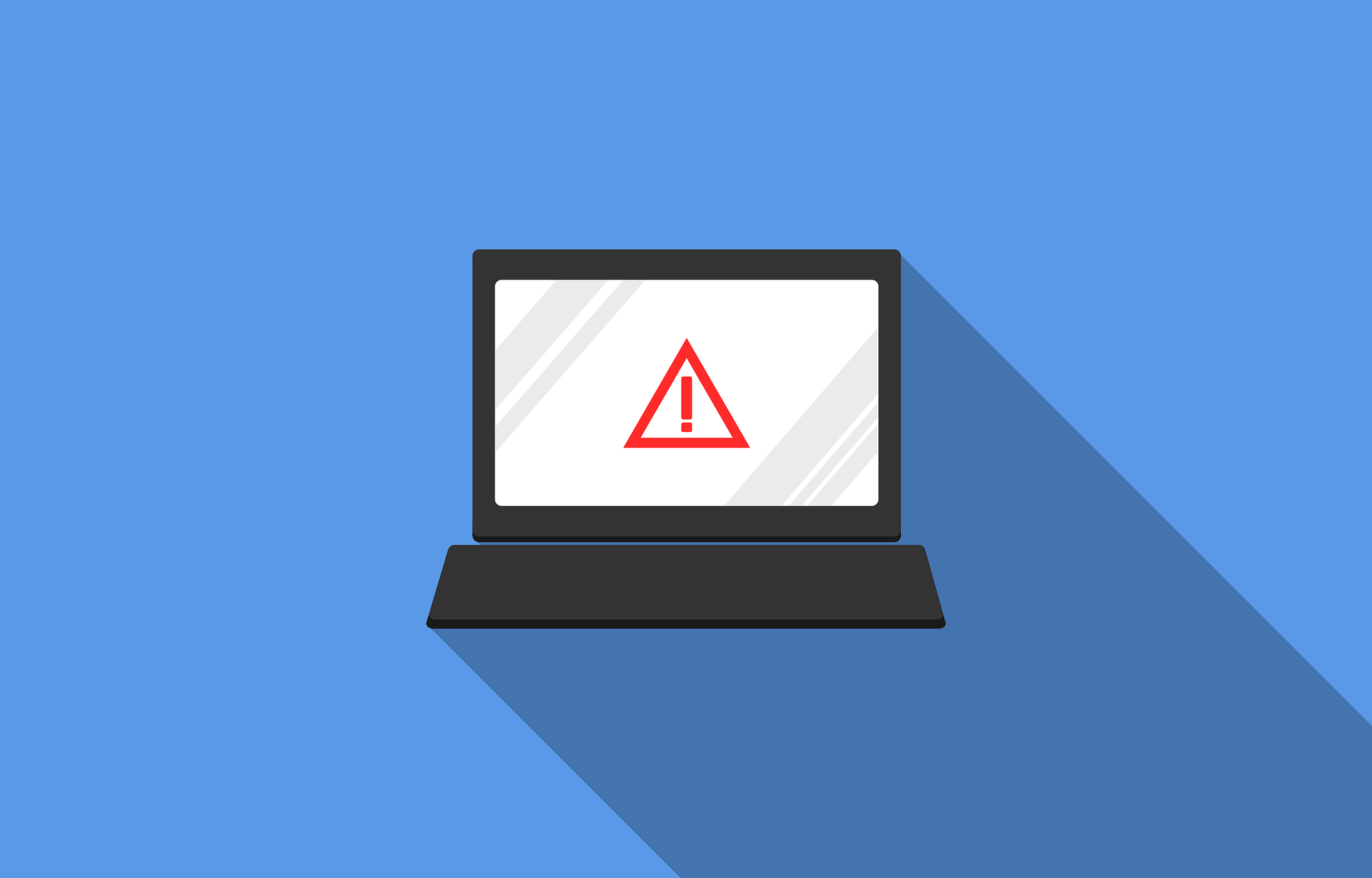
What the Connecticut Data Privacy Act means for you

5 steps you can take to protect your privacy now
